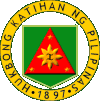Philippine Army
From Worldatplay
Revision as of 03:00, 10 January 2008
 The Philippine Army (PA) is the ground arm of the Armed Forces of the Philippines (AFP). Its official name in Filipino is Hukbong Katihan ng Pilipinas.
The Philippine Army (PA) is the ground arm of the Armed Forces of the Philippines (AFP). Its official name in Filipino is Hukbong Katihan ng Pilipinas.
History
The Philippine Army does not have a strong collective military tradition. In earlier times, Spain and the United States had been ruling the Philippine Islands. Neither allowed the Filipino troops to gain control of responsibility.
The foundation of the Philippine Army dates back to 1892, when Andrés Bonifacio founded the Katipunan organization, which aimed to prepare his band of Filipino rebels for armed revolt against Spanish colonial rule. The Katipunan first formed the nucleus of the Philippine Army.
Almost a year after the outbreak of hostilities between the Katipuneros and the Spanish Army, the Philippine Revolutionary Government and its Army were born on March 22, 1897 at Tejeros, San Francisco de Malabon in Cavite. General Artemio Ricarte was named Captain General of the Ejercito en la Republica de las Islas Filipinas or the revolutionary Philippine Army. This date marks the founding day of the modern day Philippine Army.
On June 12, 1898, Emilio Aguinaldo declared Philippine Independence from Spain and formed the first Philippine Republic, in which he sat as its President. The Filipino troops were to enjoy only a brief respite from combat when American forces came in to establish rule in the islands by virtue of the Treaty of Paris, which Spain co-signed with the United States on December 10, 1898. The treaty ceded the Philippines, Puerto Rico and Guam to the United States.
On February 4, 1899, the Philippine-American War erupted due to Filipino political struggle against U.S. annexation of the Islands. The Filipinos fell from one position to another until they were forced to disband. Even after the official cessation of hostilities and as the Americans have established government in 1901, the Filipino revolutionaries continued their struggle for independence. Between that time until 1935, the revolutionary army lost many of its cohorts in sporadic engagements with U.S. troops, but never lost its cause.
With the establishment of the Philippine Commonwealth on November 15, 1935, President Manuel L. Quezon sought the services of General Douglas MacArthur to evolve a national defense plan. Accordingly, Commonwealth Act No.1, popularly known as the National Defense Act was enacted into law, which paved the way to the birth of the new Philippine Army, which was only to be under the coat of the US Army. With an annual appropriation of 16 million pesos, it trained new Filipino members in defending the nation and protecting its people.
When World War II broke out in 1941, two regular and ten reserve divisions of the Philippine Army undertook the defense of the Philippines. These divisions were incorporated into the United States Army Forces in the Far East (USAFFE) under the command of General Douglas MacArthur. The equipment of these units included: Canon de 155mm GPF; Ordnance QF 18 pounder; 2.95 inch QF Mountain gun; Stokes Mortar; Brandt Mle 27/31; M2 Browning machine gun; M1917 Browning machine gun; M1919 Browning machine gun; M1918 Browning Automatic Rifle; M1917 Enfield rifle; M1903 Springfield rifle; Thompson submachine gun; M1 Garand; M3 Carbine; and the M1911 pistol.
After the war, four military areas were activated to take the place of military districts. The Armed Forces was reorganized which gave birth to the four major services of the Armed Forces.
Headquarters National Defense Forces was renamed General Headquarters Armed Forces of the Philippines.
In the early fifties and the mid-sixties, the Philippine government extended a helping hand to war-torn countries as part of its commitment as member of the United Nations. The army spared five battalions which comprised the Philippine Expeditionary Forces to Korea (PEFTOK) to fulfill its pledge to uphold the struggle for democracy. The Philippine Civic Action Group to Vietnam (PhilCAGV) was sent to South Vietnam on a mission of peace, where army engineers helped build communities and army doctors and nurses provided medical services to the people.
Under the leadership of Brigadier General Leoncio S. Tan the Philippine Army established its separate headquarters on July 10, 1957. The onset of the sixties ushered an expansion of the army's roles, which include participation in the socio-economic programs of the country, among others.
To achieve greater flexibility and effectiveness, infantry divisions took the place of the military areas in the seventies. During the decade, military operations supported by civic action blocked the escalation of insurgency.
The onset of the eighties saw the birth of the Special Operations Team (SOT) strategy which is aimed to isolate the insurgents from the civilian population, and dismantle the communist political organizations, neutralizing and denying them control of barangays all over the country.
Aside from counterinsurgency campaigns, the SOT plays an additional role in national development. Together with local government officials, SOT identifies problems and helps provide assistance in areas that lack needed vital facilities and service like roads, bridges, schools, health and sanitation, livelihood, etc. Because of its effectiveness in quelling insurgency, this strategy is being adopted not only by the Army but by the entire Armed Forces of the Philippines.
